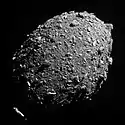161989 Cacus
161989 Cacus (prov. designation: 1978 CA) is a stony asteroid, classified as near-Earth object and a potentially hazardous asteroid of the Apollo group, approximately 1 kilometer in diameter. It was discovered on 8 February 1978, by German astronomer Hans-Emil Schuster at ESO's La Silla Observatory in northern Chile.[2] Its orbit is confined between Venus and Mars.
_Cacus.png.webp) Shape model of Cacus from its lightcurve | |
| Discovery[1][2] | |
|---|---|
| Discovered by | H.-E. Schuster |
| Discovery site | La Silla Obs. |
| Discovery date | 8 February 1978 |
| Designations | |
| (161989) Cacus | |
Named after | Cacus (Roman mythology)[2] |
| 1978 CA | |
| Apollo · NEO · PHA[1] | |
| Orbital characteristics[1] | |
| Epoch 4 September 2017 (JD 2458000.5) | |
| Uncertainty parameter 0 | |
| Observation arc | 38.59 yr (14,096 days) |
| Aphelion | 1.3634 AU |
| Perihelion | 0.8828 AU |
| 1.1231 AU | |
| Eccentricity | 0.2140 |
| 1.19 yr (435 days) | |
| 345.40° | |
| 0° 49m 41.16s / day | |
| Inclination | 26.060° |
| 161.24° | |
| 102.16° | |
| Earth MOID | 0.0152 AU · 5.9 LD |
| Physical characteristics | |
Mean diameter | 0.64±0.02 km[3] 1.126±0.073 km[4] 1.86 km[5] 1.9 km[6] |
| 3.7538±0.0019 h[6] 3.756 h[7] 3.761 h[5] 3.77±0.11 h[8] | |
| 0.09[6] 0.119 (derived)[6] 0.199±0.052[4] 0.46±0.09[3] | |
| Tholen = S[1][6] · Q[9] B–V = 0.910[1] U–B = 0.484[1] | |
| 16.58[6][7] · 17.1[4] · 17.2[1] · 17.32[5] · 17.43[3] | |
This minor planet was named from Roman mythology, after Cacus, a fire-breathing monster, which was killed by Hercules.[2] The official naming citation was published by the Minor Planet Center on 24 November 2007 (M.P.C. 61270).[10]
| Date | JPL SBDB nominal geocentric distance |
uncertainty region (3-sigma) |
|---|---|---|
| 1941-09-02 | 2418754 km | ± 6 km |
| 2022-09-01 | 8607710 km | ± 21 km[11] |
References
- "JPL Small-Body Database Browser: 161989 Cacus (1978 CA)" (2016-09-12 last obs.). Jet Propulsion Laboratory. Archived from the original on 22 November 2020. Retrieved 13 January 2018.
- "161989 Cacus (1978 CA)". Minor Planet Center. Retrieved 13 January 2018.
- Nugent, C. R.; Mainzer, A.; Bauer, J.; Cutri, R. M.; Kramer, E. A.; Grav, T.; et al. (September 2016). "NEOWISE Reactivation Mission Year Two: Asteroid Diameters and Albedos". The Astronomical Journal. 152 (3): 12. arXiv:1606.08923. Bibcode:2016AJ....152...63N. doi:10.3847/0004-6256/152/3/63.
- Mainzer, A.; Grav, T.; Masiero, J.; Hand, E.; Bauer, J.; Tholen, D.; et al. (November 2011). "NEOWISE Studies of Spectrophotometrically Classified Asteroids: Preliminary Results". The Astrophysical Journal. 741 (2): 25. arXiv:1109.6407. Bibcode:2011ApJ...741...90M. doi:10.1088/0004-637X/741/2/90.
- Degewij, J.; Lebofsky, L.; Lebofsky, M. (March 1978). "1978 CA and 1978 DA". IAU Circ. 3193 (3193): 1. Bibcode:1978IAUC.3193....1D. Retrieved 13 January 2018.
- "LCDB Data for (161989) Cacus". Asteroid Lightcurve Database (LCDB). Retrieved 13 January 2018.
- Schuster, H. E.; Surdej, A.; Surdej, J. (September 1979). "Photoelectric observations of two unusual asteroids - 1978 CA and 1978 DA". Astronomy and Astrophysics Supplement Series. 37: 483–486. Bibcode:1979A&AS...37..483S.
- Koehn, Bruce W.; Bowell, Edward G.; Skiff, Brian A.; Sanborn, Jason J.; McLelland, Kyle P.; Pravec, Petr; et al. (October 2014). "Lowell Observatory Near-Earth Asteroid Photometric Survey (NEAPS) - 2009 January through 2009 June". The Minor Planet Bulletin. 41 (4): 286–300. Bibcode:2014MPBu...41..286K. ISSN 1052-8091.
- Thomas, Cristina A.; Emery, Joshua P.; Trilling, David E.; Delbó, Marco; Hora, Joseph L.; Mueller, Michael (January 2014). "Physical characterization of Warm Spitzer-observed near-Earth objects". Icarus. 228: 217–246. arXiv:1310.2000. Bibcode:2014Icar..228..217T. doi:10.1016/j.icarus.2013.10.004.
- "MPC/MPO/MPS Archive". Minor Planet Center. Retrieved 13 January 2018.
- "Horizons Batch for 2022-Sep-01 06:54 UT". JPL Horizons. Archived from the original on 17 January 2022. Retrieved 17 January 2022.
External links
- Lightcurve Database Query (LCDB), at www.minorplanet.info
- Dictionary of Minor Planet Names, Google books
- Asteroids and comets rotation curves, CdR – Geneva Observatory, Raoul Behrend
- 161989 Cacus at NeoDyS-2, Near Earth Objects—Dynamic Site
- 161989 Cacus at ESA–space situational awareness
- 161989 Cacus at the JPL Small-Body Database
This article is issued from Wikipedia. The text is licensed under Creative Commons - Attribution - Sharealike. Additional terms may apply for the media files.

